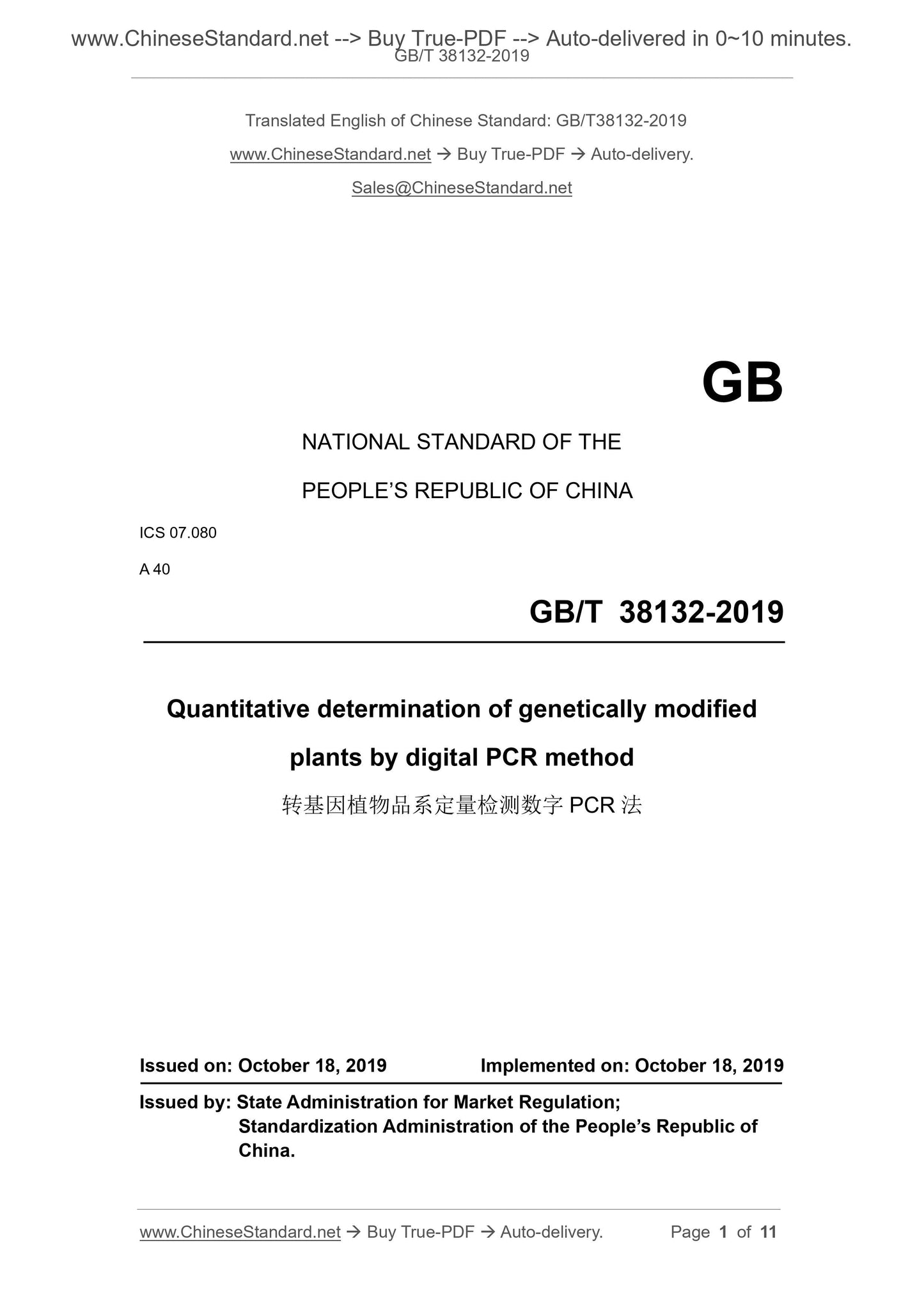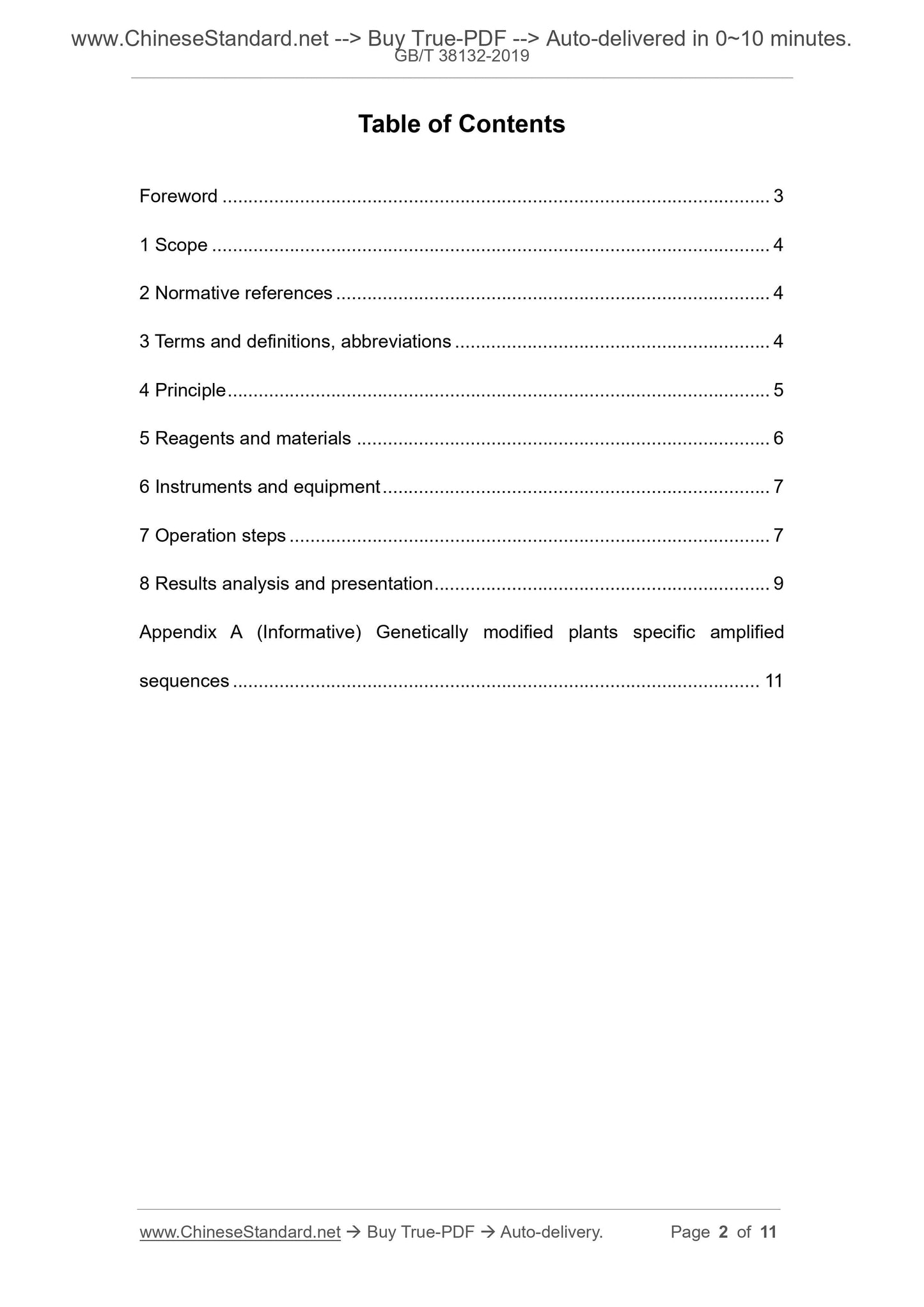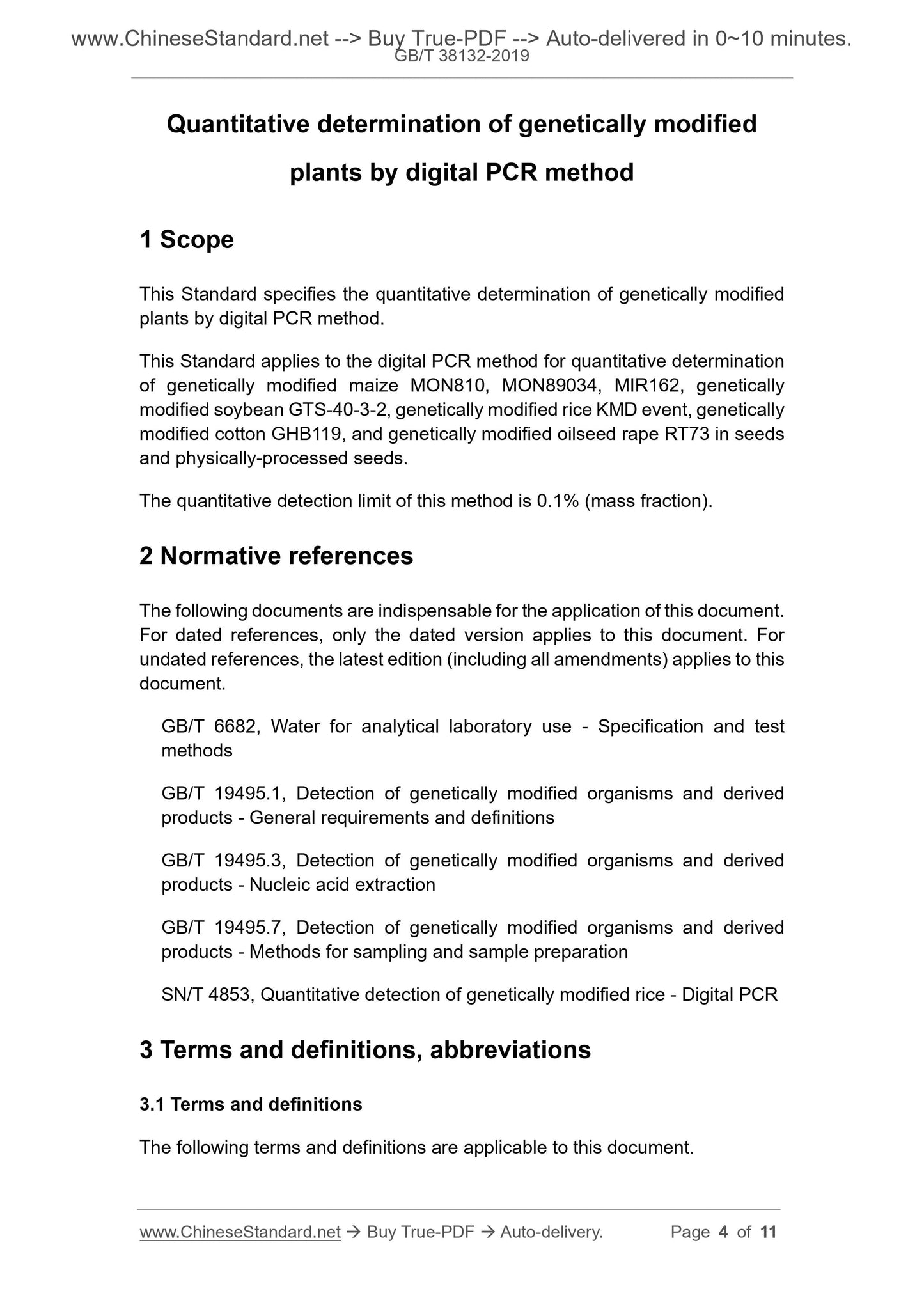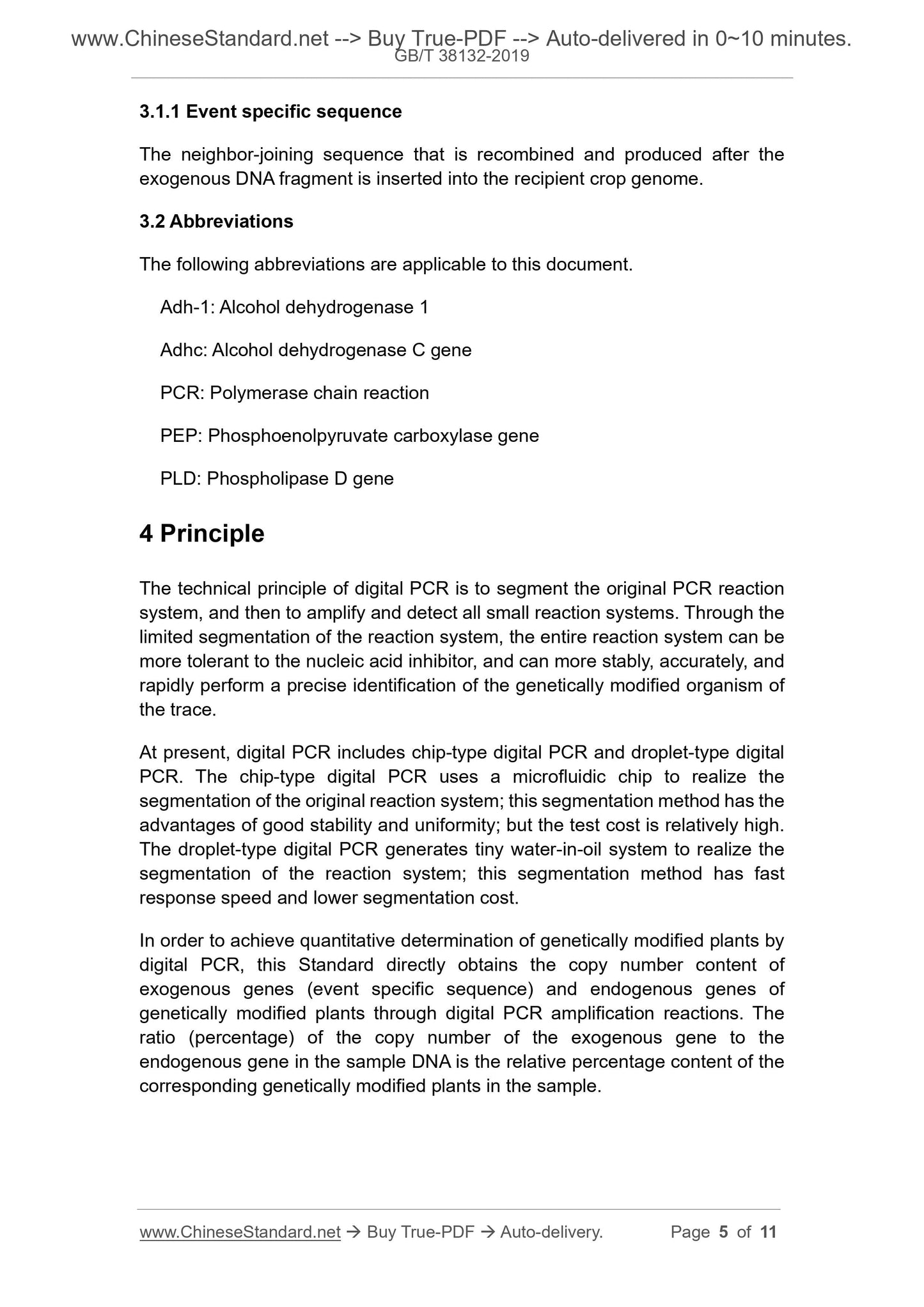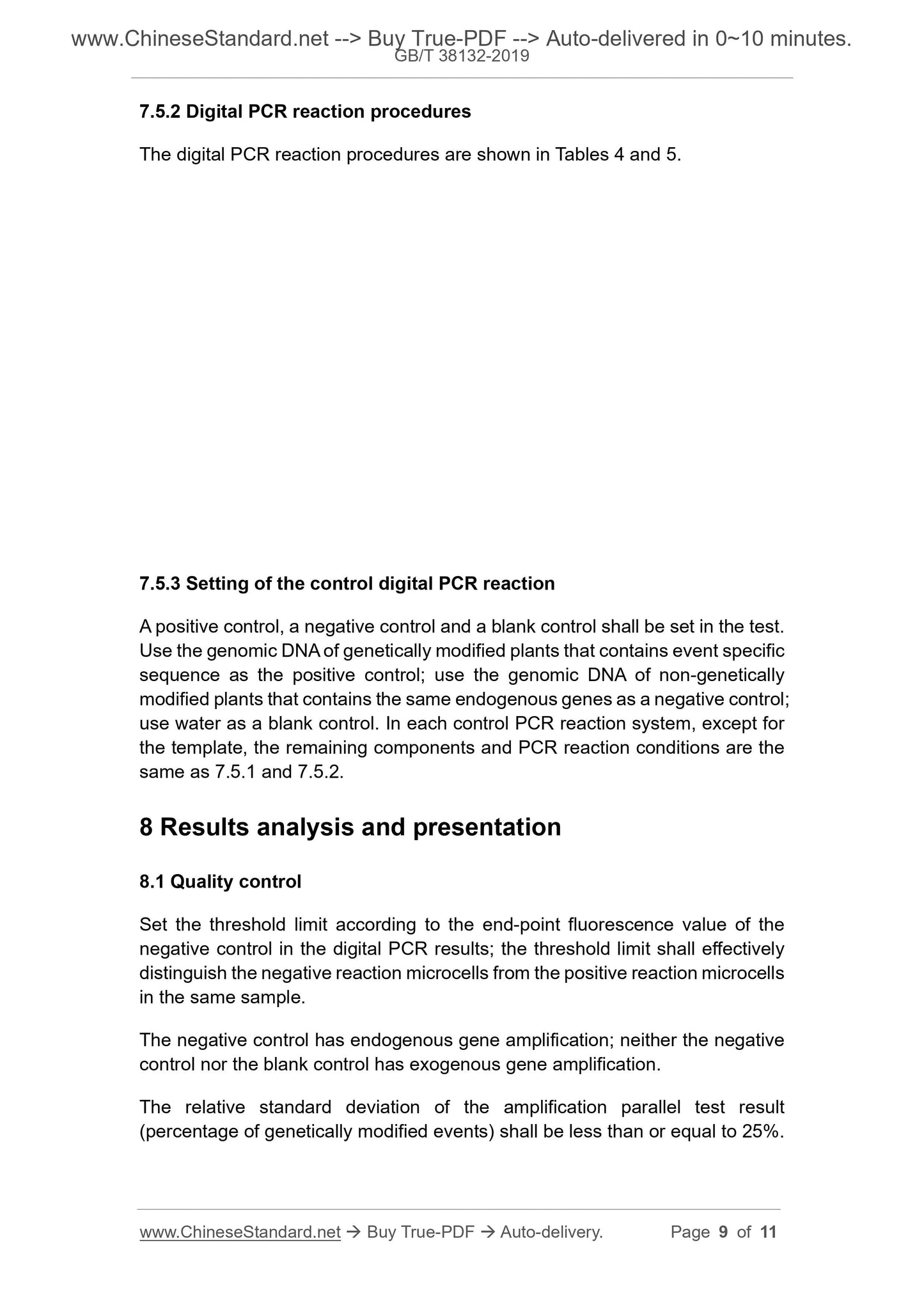1
/
of
5
PayPal, credit cards. Download editable-PDF and invoice in 1 second!
GB/T 38132-2019 English PDF (GBT38132-2019)
GB/T 38132-2019 English PDF (GBT38132-2019)
Regular price
$150.00 USD
Regular price
Sale price
$150.00 USD
Unit price
/
per
Shipping calculated at checkout.
Couldn't load pickup availability
Delivery: 3 seconds. Download true-PDF + Invoice.
Get QUOTATION in 1-minute: Click GB/T 38132-2019
Historical versions: GB/T 38132-2019
Preview True-PDF (Reload/Scroll if blank)
GB/T 38132-2019: Quantitative determination of genetically modified plants by digital PCR method
GB/T 38132-2019
NATIONAL STANDARD OF THE
PEOPLE’S REPUBLIC OF CHINA
ICS 07.080
A 40
Quantitative determination of genetically modified
plants by digital PCR method
ISSUED ON: OCTOBER 18, 2019
IMPLEMENTED ON: OCTOBER 18, 2019
Issued by: State Administration for Market Regulation;
Standardization Administration of the People’s Republic of
China.
Table of Contents
Foreword ... 3
1 Scope ... 4
2 Normative references ... 4
3 Terms and definitions, abbreviations ... 4
4 Principle ... 5
5 Reagents and materials ... 6
6 Instruments and equipment ... 7
7 Operation steps ... 7
8 Results analysis and presentation ... 9
Appendix A (Informative) Genetically modified plants specific amplified
sequences ... 11
Quantitative determination of genetically modified
plants by digital PCR method
1 Scope
This Standard specifies the quantitative determination of genetically modified
plants by digital PCR method.
This Standard applies to the digital PCR method for quantitative determination
of genetically modified maize MON810, MON89034, MIR162, genetically
modified soybean GTS-40-3-2, genetically modified rice KMD event, genetically
modified cotton GHB119, and genetically modified oilseed rape RT73 in seeds
and physically-processed seeds.
The quantitative detection limit of this method is 0.1% (mass fraction).
2 Normative references
The following documents are indispensable for the application of this document.
For dated references, only the dated version applies to this document. For
undated references, the latest edition (including all amendments) applies to this
document.
GB/T 6682, Water for analytical laboratory use - Specification and test
methods
GB/T 19495.1, Detection of genetically modified organisms and derived
products - General requirements and definitions
GB/T 19495.3, Detection of genetically modified organisms and derived
products - Nucleic acid extraction
GB/T 19495.7, Detection of genetically modified organisms and derived
products - Methods for sampling and sample preparation
SN/T 4853, Quantitative detection of genetically modified rice - Digital PCR
3 Terms and definitions, abbreviations
3.1 Terms and definitions
The following terms and definitions are applicable to this document.
3.1.1 Event specific sequence
The neighbor-joining sequence that is recombined and produced after the
exogenous DNA fragment is inserted into the recipient crop genome.
3.2 Abbreviations
The following abbreviations are applicable to this document.
Adh-1: Alcohol dehydrogenase 1
Adhc: Alcohol dehydrogenase C gene
PCR: Polymerase chain reaction
PEP: Phosphoenolpyruvate carboxylase gene
PLD: Phospholipase D gene
4 Principle
The technical principle of digital PCR is to segment the original PCR reaction
system, and then to amplify and detect all small reaction systems. Through the
limited segmentation of the reaction system, the entire reaction system can be
more tolerant to the nucleic acid inhibitor, and can more stably, accurately, and
rapidly perform a precise identification of the genetically modified organism of
the trace.
At present, digital PCR includes chip-type digital PCR and droplet-type digital
PCR. The chip-type digital PCR uses a microfluidic chip to realize the
segmentation of the original reaction system; this segmentation method has the
advantages of good stability and uniformity; but the test cost is relatively high.
The droplet-type digital PCR generates tiny water-in-oil system to realize the
segmentation of the reaction system; this segmentation method has fast
response speed and lower segmentation cost.
In order to achieve quantitative determination of genetically modified plants by
digital PCR, this Standard directly obtains the copy number content of
exogenous genes (event specific sequence) and endogenous genes of
genetically modified plants through digital PCR amplification reactions. The
ratio (percentage) of the copy number of the exogenous gene to the
endogenous gene in the sample DNA is the relative percentage content of the
corresponding genetically modified plants in the sample.
7.5.2 Digital PCR reaction procedures
The digital PCR reaction procedures are shown in Tables 4 and 5.
7.5.3 Setting of the control digital PCR reaction
A positive control, a negative control and a blank control shall be set in the test.
Use the genomic DNA of genetically modified plants that contains event specific
sequence as the positive control; use the genomic DNA of non-genetically
modified plants that contains the same endogenous genes as a negative control;
use water as a blank control. In each control PCR reaction system, except for
the template, the remaining components and PCR reaction conditions are the
same as 7.5.1 and 7.5.2.
8 Results analysis and presentation
8.1 Quality control
Set the threshold limit according to the end-point fluorescence value of the
negative control in the digital PCR results; the threshold limit shall effectively
distinguish the negative reaction microcells from the positive reaction microcells
in the same sample.
The negative control has endogenous gene amplification; neither the negative
control nor the blank control has exogenous gene amplification.
The relative standard deviation of the amplification parallel test result
(percentage of genetically modified events) shall be less than or equal to 25%.
Get QUOTATION in 1-minute: Click GB/T 38132-2019
Historical versions: GB/T 38132-2019
Preview True-PDF (Reload/Scroll if blank)
GB/T 38132-2019: Quantitative determination of genetically modified plants by digital PCR method
GB/T 38132-2019
NATIONAL STANDARD OF THE
PEOPLE’S REPUBLIC OF CHINA
ICS 07.080
A 40
Quantitative determination of genetically modified
plants by digital PCR method
ISSUED ON: OCTOBER 18, 2019
IMPLEMENTED ON: OCTOBER 18, 2019
Issued by: State Administration for Market Regulation;
Standardization Administration of the People’s Republic of
China.
Table of Contents
Foreword ... 3
1 Scope ... 4
2 Normative references ... 4
3 Terms and definitions, abbreviations ... 4
4 Principle ... 5
5 Reagents and materials ... 6
6 Instruments and equipment ... 7
7 Operation steps ... 7
8 Results analysis and presentation ... 9
Appendix A (Informative) Genetically modified plants specific amplified
sequences ... 11
Quantitative determination of genetically modified
plants by digital PCR method
1 Scope
This Standard specifies the quantitative determination of genetically modified
plants by digital PCR method.
This Standard applies to the digital PCR method for quantitative determination
of genetically modified maize MON810, MON89034, MIR162, genetically
modified soybean GTS-40-3-2, genetically modified rice KMD event, genetically
modified cotton GHB119, and genetically modified oilseed rape RT73 in seeds
and physically-processed seeds.
The quantitative detection limit of this method is 0.1% (mass fraction).
2 Normative references
The following documents are indispensable for the application of this document.
For dated references, only the dated version applies to this document. For
undated references, the latest edition (including all amendments) applies to this
document.
GB/T 6682, Water for analytical laboratory use - Specification and test
methods
GB/T 19495.1, Detection of genetically modified organisms and derived
products - General requirements and definitions
GB/T 19495.3, Detection of genetically modified organisms and derived
products - Nucleic acid extraction
GB/T 19495.7, Detection of genetically modified organisms and derived
products - Methods for sampling and sample preparation
SN/T 4853, Quantitative detection of genetically modified rice - Digital PCR
3 Terms and definitions, abbreviations
3.1 Terms and definitions
The following terms and definitions are applicable to this document.
3.1.1 Event specific sequence
The neighbor-joining sequence that is recombined and produced after the
exogenous DNA fragment is inserted into the recipient crop genome.
3.2 Abbreviations
The following abbreviations are applicable to this document.
Adh-1: Alcohol dehydrogenase 1
Adhc: Alcohol dehydrogenase C gene
PCR: Polymerase chain reaction
PEP: Phosphoenolpyruvate carboxylase gene
PLD: Phospholipase D gene
4 Principle
The technical principle of digital PCR is to segment the original PCR reaction
system, and then to amplify and detect all small reaction systems. Through the
limited segmentation of the reaction system, the entire reaction system can be
more tolerant to the nucleic acid inhibitor, and can more stably, accurately, and
rapidly perform a precise identification of the genetically modified organism of
the trace.
At present, digital PCR includes chip-type digital PCR and droplet-type digital
PCR. The chip-type digital PCR uses a microfluidic chip to realize the
segmentation of the original reaction system; this segmentation method has the
advantages of good stability and uniformity; but the test cost is relatively high.
The droplet-type digital PCR generates tiny water-in-oil system to realize the
segmentation of the reaction system; this segmentation method has fast
response speed and lower segmentation cost.
In order to achieve quantitative determination of genetically modified plants by
digital PCR, this Standard directly obtains the copy number content of
exogenous genes (event specific sequence) and endogenous genes of
genetically modified plants through digital PCR amplification reactions. The
ratio (percentage) of the copy number of the exogenous gene to the
endogenous gene in the sample DNA is the relative percentage content of the
corresponding genetically modified plants in the sample.
7.5.2 Digital PCR reaction procedures
The digital PCR reaction procedures are shown in Tables 4 and 5.
7.5.3 Setting of the control digital PCR reaction
A positive control, a negative control and a blank control shall be set in the test.
Use the genomic DNA of genetically modified plants that contains event specific
sequence as the positive control; use the genomic DNA of non-genetically
modified plants that contains the same endogenous genes as a negative control;
use water as a blank control. In each control PCR reaction system, except for
the template, the remaining components and PCR reaction conditions are the
same as 7.5.1 and 7.5.2.
8 Results analysis and presentation
8.1 Quality control
Set the threshold limit according to the end-point fluorescence value of the
negative control in the digital PCR results; the threshold limit shall effectively
distinguish the negative reaction microcells from the positive reaction microcells
in the same sample.
The negative control has endogenous gene amplification; neither the negative
control nor the blank control has exogenous gene amplification.
The relative standard deviation of the amplification parallel test result
(percentage of genetically modified events) shall be less than or equal to 25%.
Share
